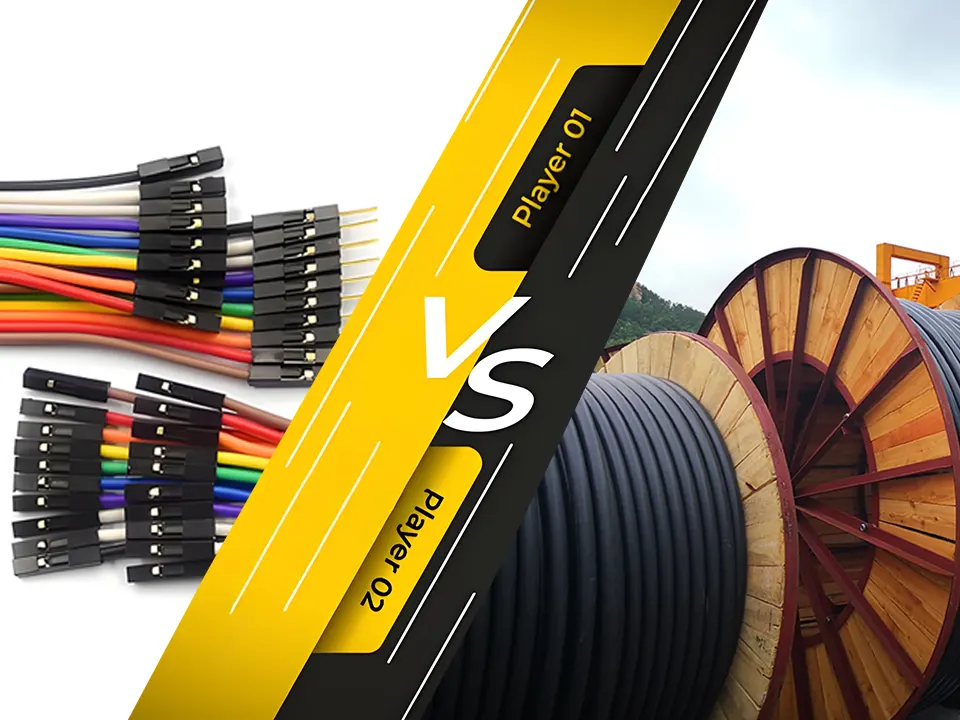Differences Between Wire and Cable
The differences between wire and cable mainly lie in their physical structure, functional applications, electrical performance, and usage scenarios.
A wire typically refers to a single conductor with a simple and flexible design, suitable for low-load conditions.
A cable, on the other hand, consists of multiple wires bundled together, offering enhanced insulation and protection, making it ideal for high-current transmission or long-distance power and signal delivery.

Below is a detailed explanation across the core dimensions:
I. Structural Composition and Material Differences
Wire Structure
A wire usually consists of a single metallic conductor (such as copper or aluminum). It may be bare or covered with an insulation layer.
For example, magnet wire is coated with a very thin enamel layer, while household electrical wire is insulated with PVC.
Wires are generally lightweight, smaller in diameter, and easy to bend, making them suitable for localized routing in compact wiring harness assemblies.
Cable Structure
A cable is made up of multiple wires twisted or laid in parallel, with additional layers of insulation, shielding, and sometimes metallic armor.
For instance, Ethernet cables contain four twisted pairs with foil shielding and a PVC jacket.
High-voltage power cables may also incorporate a steel armor layer, improving mechanical strength, pressure resistance, and corrosion protection.
II. Functional Roles and Typical Applications
Wire in Lightweight Applications
Due to its flexibility, wire is widely used for internal connections in small devices (such as jumper wires on PCBs), power cords for portable appliances (such as lamp cords), and short-distance, low-voltage connections (such as battery leads).
Cable in High-Load and Harsh Environments
Cables are designed for demanding applications such as power distribution lines (e.g., underground transmission cables), data communication (e.g., fiber optic cables), and industrial machinery (e.g., power supply cables for cranes).
Their multilayer construction provides superior resistance to electromagnetic interference (EMI), mechanical abrasion, and moisture ingress.
III. Electrical Performance and Safety Standards
Conductivity and Voltage Rating
The conductivity of a single wire depends on its cross-sectional area and material, but its current-carrying capacity is relatively limited.
Cables, by using multiple conductors in parallel or twisted configurations, can carry significantly higher currents, with voltage ratings often exceeding 600V (e.g., YJV power cables).
Safety and Protection Levels
Wires typically have insulation thickness ranging from 0.5–1 mm, sufficient for standard environments.
Cables, however, feature jackets up to 2–5 mm thick, with certain types offering flame-retardant properties (such as UL94 V-0 compliance) or chemical resistance (such as TPU sheathing).
IV. Cost and Maintenance Complexity
Production Cost Differences
Cables require more raw materials (e.g., copper conductors, multilayer insulation) and more complex manufacturing processes (e.g., twisting, shielding, armoring).
As a result, cables are usually 2–5 times more expensive than comparable wires.
For instance, cables with the same copper specification are significantly more costly than single-core wires.
Maintenance and Fault Diagnosis
Wires have a simple design, making them easy to replace if damaged.
Cables, however, can be more challenging to service—internal short circuits or jacket failures often require specialized equipment (such as cable fault locators) for troubleshooting, leading to higher maintenance costs.
Conclusion
When selecting between wire and cable, factors such as current capacity, environmental conditions, and budget must be carefully evaluated.
For temporary wiring or lightweight applications, wire offers better cost efficiency.
For high reliability, long-distance transmission, or industrial-grade applications, cable is the superior choice.
If you need custom wire harnesses, whether for wire or cable, Kaweei can provide the right solution. Feel free to contact us anytime!


